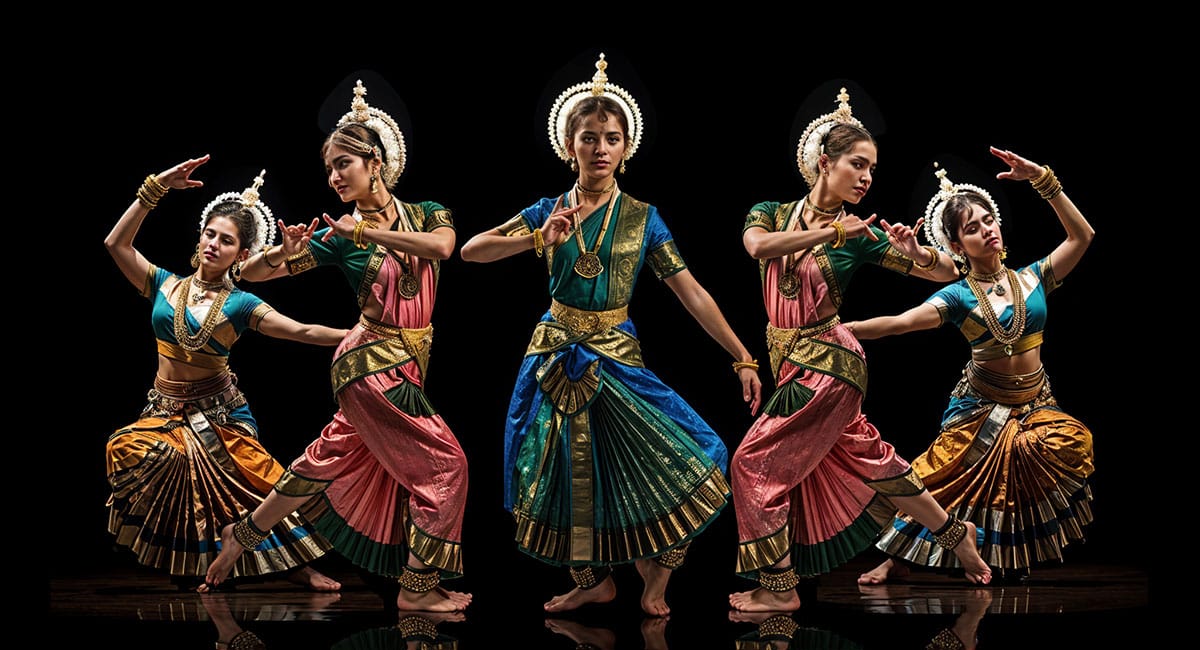Gharanas of Odissi Dance (India)
Odissi, one of India’s eight classical dance forms, is known for its elegant movements, complex footwork, and emotive expressions. With roots tracing back to the ancient temples of Odisha, this dance form has evolved over centuries, shaped by various stylistic traditions known as gharanas. These gharanas have been crucial in refining Odissi’s aesthetics, technical nuances, and interpretative styles.
Understanding Gharanas in Odissi Dance
The concept of gharanas in Indian classical dance and music refers to distinct stylistic traditions that emerge based on geographic regions, master-disciple lineages, and philosophical underpinnings. In Odissi, the gharanas primarily developed through the contributions of great gurus, each imparting their artistic visions to the dance form.
The four major Gharanas of Odissi dance are:
- Guru Pankaj Charan Das Gharana
- Guru Kelucharan Mohapatra Gharana
- Guru Deba Prasad Das Gharana
- Guru Mayadhar Raut Gharana
These gharanas have distinct characteristics that set them apart while contributing to the broader tradition of Odissi dance.
Guru Pankaj Charan Das Gharana
Temple Style of Odissi:
People regard Guru Pankaj Charan Das as the “Adi Guru” of Odissi dance. His gharana has deep roots in the Mahari tradition, a ritualistic dance performed by female temple dancers (Maharis) in the Jagannath temple of Puri. This tradition focused on devotional themes and spiritual storytelling.
Key Features of this Gharana:
- Graceful, fluid movements emphasize the feminine energy (Lasya aspect).
- Deep spiritual essence, often drawing from devotional themes.
- Delicate torso movements resemble the iconography of temple sculptures.
- Focus on Abhinaya (expressive storytelling) with subtle facial expressions and complex hand gestures.
- Slow, lyrical pace that maintains the sanctity of the dance’s spiritual origins.
This gharana is known for its soft, lyrical elegance, reflecting the deep devotion of the Mahari tradition.
Guru Kelucharan Mohapatra Gharana
Iconic Style of Odissi:
Guru Kelucharan Mohapatra often popularized Odissi dance globally. His gharana integrates elements from the Gotipua (a tradition where young boys performed acrobatic dances) and Mahari traditions, creating a balanced and refined style.
Key Features of this Gharana:
- Sculpturesque poses, drawing inspiration from Odisha’s ancient temple carvings.
- Perfect coordination of bhava (expression), raga (melody), and tala (rhythm).
- A refined balance between lasya (grace) and tandava (vigorous movements).
- Strong chauk (square stance) and tribhangi (three-bend posture) postures.
- Precision in footwork, often marked by rhythmic intricacies.
His legacy has created a highly codified and structured approach to Odissi dance, which institutions and performers worldwide widely accept.
Guru Deba Prasad Das Gharana
Dynamic and Rhythmic Style:
Guru Deba Prasad Das’s gharana is known for its vigorous and dynamic style, incorporating elements from Odisha’s tribal and folk dance traditions. This gharana is distinct due to its powerful expressions and robust stage presence.
Key Features of this Gharana:
- Bold and energetic movements with a strong emphasis on rhythm.
- Influences from tribal and martial dance traditions of Odisha.
- Greater use of space, with dancers covering more ground in their performances.
- Powerful expressions and theatrical elements make it a dramatic style.
- Innovative choreography, blending traditional Odissi with indigenous dance forms.
The Deba Prasad Das Gharana is widely appreciated for its raw energy and ability to merge classical and folk music, giving Odissi performances a robust and earthy feel.
Guru Mayadhar Raut Gharana
Theatrical and Expressive Style:
Guru Mayadhar Raut is credited with introducing Sringara Rasa (erotic sentiment) into Odissi dance, bringing a more expressive and theatrical quality to performances. His style places significant emphasis on literary and poetic interpretations.
Key Features of this Gharana:
- Expressive storytelling (Abhinaya) with elaborate facial expressions.
- Greater focus on literary and poetic interpretations from sources like Jayadeva’s Gita Govinda.
- Sanchari Bhava’s introduction enables the dancer to go into several levels of meaning in a single story.
- Subtle movements bring a sensuous and lyrical quality to the dance.
- Sophisticated hand gestures (Mudras) and eye movements (Drishti Bheda).
This gharana is revered for its rich narrative depth and heightened emotional appeal in performance.
The Importance of Gharanas in Modern Odissi
The Gharanas of Odissi dance are more than just stylistic variations; they preserve tradition and innovation within the art form. Today, Odissi dancers train in different Gharanas or blend elements from multiple styles to create interpretations. The diversity of Gharanas ensures that Odissi remains a living and evolving tradition, adaptable to contemporary themes while retaining its classical essence.
While purists may advocate for strict adherence to a single Gharana, modern performers often incorporate elements from various styles, creating fusion pieces that retain the elegance of Odissi while appealing to contemporary audiences.
Final Thoughts
The Gharanas of Odissi dance represent the diverse artistic visions of the great gurus who shaped this classical dance form. Each gharana brings its unique approach to movement, rhythm, expression, and philosophy, ensuring that Odissi continues to flourish in its traditional roots and modern adaptations. Whether a dancer follows a single gharana or blends elements from multiple traditions, the richness of Odissi’s Gharanas ensures that this beautiful dance form remains timeless and ever-evolving.


